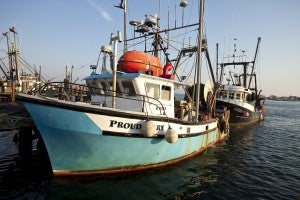Accumulation Limits a Critical Component of Catch Shares to Provide Benefits to Fishing Families and Communities
 Catch shares, a fishery management system that gives fishermen a secure share of the catch in exchange for increased monitoring and greater accountability, represent a substantial change from the way U.S. fisheries have been managed in the past.
Catch shares, a fishery management system that gives fishermen a secure share of the catch in exchange for increased monitoring and greater accountability, represent a substantial change from the way U.S. fisheries have been managed in the past.
Well-designed catch shares – particularly when they include accumulation limits – can provide safeguards for small boat fishermen, their families, and their communities. Because these are the people who are hurt most when fisheries collapse, EDF believes it is imperative to ensure that management programs take the needs of both fish and fishermen into account. Catch shares are uniquely suited to do so in a number of ways that conventional fishery management plans could not.
For example, conventional fishery management plans typically call for shortened seasons and even closures when overfishing or other factors deplete stocks. This unpredictability of management can endanger smaller operators more than bigger ones, since they may not have the flexibility to weather the changes. Because catch shares usually allow fishermen to operate all year long, they provide far greater job stability for fishermen, who know in advance how much fish they can catch during the season and what their needs will be at any given time. They can spread their catch out over the year, avoiding the gluts that occur when everyone brings in their catch at once and timing trips to maximize the price they’ll earn for that catch. Some fishermen are working directly with processors so they are fishing for species that are most sought-after at the most desirable times, earning the highest price per fish.
With longer seasons, fishermen can also take time off for needed boat repairs, and avoid working under the most dangerous weather conditions. These are welcome changes for many fishermen, who had grown accustomed to having to work at a frenzied pace whenever regulators said they could, with no flexibility to come in during dangerous weather or stay out when the fishing was good.
Industry consolidation continues to be a concern due to climate change and the fact that there simply aren’t as many fish in the sea. While fleets have been shrinking for decades, catch shares allow fishery managers to set limits on consolidation when this is a concern.
Accumulation limits are designed to put reasonable caps on the control or ownership of fishing quota. Most catch share programs in North America have established accumulation limits to control fleet consolidation and to make sure that quota ownership is spread across a large enough number of participants in order to limit market power and fishing opportunity by a few individuals or companies.
There is no single way to set accumulation limits, and in fact, they are typically tailored to the characteristics of individual fisheries and the management goals of that fishery. Some fisheries have set high limits in order to allow for consolidation (such as a 25 percent consolidation cap for the New Zealand shore side sector), while others are low (such as a 1 percent cap for Alaska halibut).
These kinds of tools allow fishery managers to set up a system that protects fishing communities and fishing families from instability and the kind of rampant consolidation that had been going unchecked for years.
Catch shares provide the framework for the future – and with the right structure and features, this system is well suited to help protect fish and fishermen.












